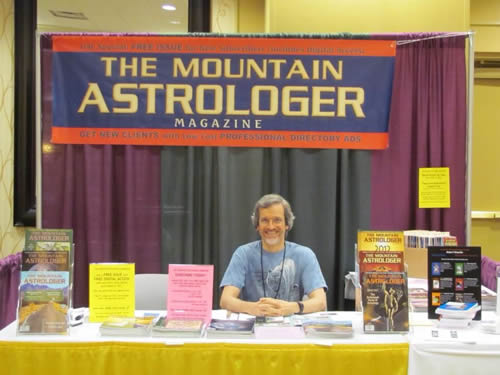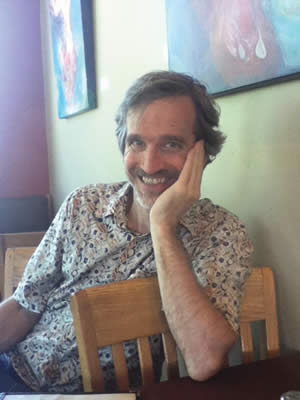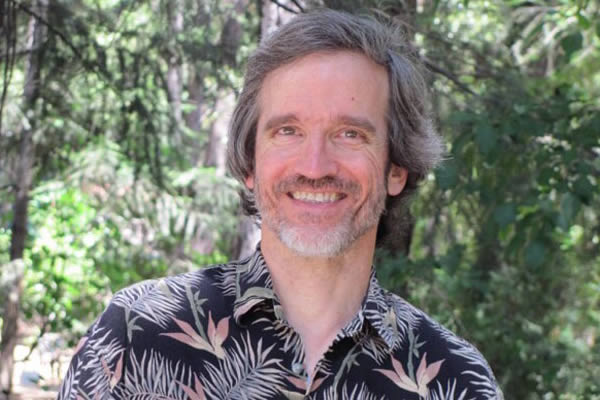Goodbye Tem
by Steven Forrest
Tem Tarriktar, the beloved publisher of The Mountain Astrologer magazine, passed away last July 8th. He had thyroid cancer. In the Age of Facebook and Instagram, most of you reading this probably knew of his illness and his heroic battle against it over the past many months. Likely, you knew of his passing within hours as well. Astrology is a small world, and at times such as this, our field and all of us who comprise it feel like a family. Death draws us all a little closer to the ancient hearth-fire.
All the standard things one might say in the face of such a loss remain true, even though familiarity might weaken them to the point that they sound like cliches: Tem will be sorely missed. Our hearts go out to those he left behind. We will always remember him. We know he lives on in spirit and in his legacy of great work.
All true. All those words need to be said. All of them are felt deeply by anyone who knew Tem personally, and by many who knew him only though his good works. Even if we did not have the joy of knowing him personally, every one of us in the community benefited from his kindness, wisdom, and competence in sustaining The Mountain Astrologer over all these years.
It’s hard for me to believe, but the first time I met Tem Tarriktar was a little over thirty years ago. Our first encounter happened at the United Astrology Congress in New Orleans, back in 1989. Time flies. I had a couple of books in print with Bantam by then and I had begun to make a little splash in AstroWorld, so Tem knew who I was. At that point, I had never heard of him. If memory serves, he approached me about a possible interview for this crazy magazine he was trying to start. He had rented a booth at the trade show to help promote it.
I liked Tem right away, but his whole enterprise seemed impossibly dubious. The “magazine” was homespun at best – photocopied or perhaps even mimeographed, if I am remembering correctly.
He gave me the impression that his total start-up budget for The Mountain Astrologer might feed a family of four for a week or two, provided they really liked pizza.
As we got to know each other, Tem confirmed that “wing-and-a-prayer” impression by admitting that he was saving money by sleeping under his table at the Trade Show. He would wait until Security turned its back, then he would duck behind the bunting at the end of the day. He couldn’t afford “a room at the inn.”
Of course I appreciated Tem’s rebel spirit immediately – his massive dose of Leo energy lit up my Aries Moon. And I also knew that with that kind of determination and chutzpah, The Mountain Astrologer was going to make it despite the odds and all reason.
And “make it” it did. Two hundred monthly issues later, it is still going strong.
All reports are that the magazine will continue to be published despite the loss of Tem. With the current exponential expansion in public interest in astrology, I suspect it will thrive. If pride exists in the realms where Tem is now soaring, I am confident that he will be proud. And I am also sure he will be phoning in his editorial suggestions from the astral world, whispering pointed suggestions into the dream-ears of those who will take the helm.
In the past and in the mysterious future, Tem could naturally never have done any of this alone. Reading off the masthead, I want to honor and thank Nan Geary, Linda Kaye, Mary Plumb, Kate Sholly, Frank C. Clifford, Ray Grasse, Janette DeProsse, Sara Fisk, Linda Byrd, Linda Ferencik, and Ann Meigs for their own hard work in the endless effort of cranking out such a high quality magazine – and never missing a publication date, despite hell, high water, and Pluto transits.
There has always been much to love about The Mountain Astrologer. The best part, to me, has been the way it has functioned as a kind of collective “watering hole,” where partisans of all the different, fragmented branches of our craft could come together as equals and possibly even learn something from each other. Evolutionary astrologers, Hellenists, Cosmobiologists, Uranian astrologers, Jyotish practitioners, Horary astrologers, astro-economists – all were welcome in the pages of TMA.
That inclusiveness addressed a major intellectual problem we astrologers face – trying to maintain some kind of common bond of shared language in the face of our enormous diversity – but more importantly to me, Tem’s wide-open welcome mat addressed a spiritual problem: that is simply the risk of division shattering our community. Blithe affirmations that “we are all doing the same thing” may politely defuse arguments – and such affirmations are soul-miles ahead of anyone condemning the other person’s house system or zodiac, thus sowing seeds of pointless competition and suspicion.
Still, the various astrological systems are in fact quite different from each other, and truly listening “across the aisle” has never been easy. In the words of U2, Tem always reminded us all that “we are one, but we are not the same.” Tem, in other words, did not make the issue of fragmentation any easier than it could honestly be made, but by creating common ground where we could all meet, he at least made addressing it possible.
Of all Tem’s many gifts to the astrological family over the past three decades, it is that one for which I am most grateful. I salute his great soul for bringing that living example of inclusiveness, generosity, and respect for diversity to us all. Perhaps more than any other figure in the landscape of current astrological practice, he embodied the notion of rising above our differences and affirming that we all live under one sky.
I just called this inclusive message Tem’s“gift,” which is correct. But I also call it his challenge to us – a challenge to which we are still rising as a community.

As synchronicity would have it, I am writing these words at the Omega Institute for Holistic Studies in Rhinebeck, New York, where I am currently teaching a five-day class. At the moment, I am sitting in the quiet upstairs of the Ram Dass Library, which has the finest collection of 20th and 21st century “consciousness literature” I have ever seen.
Omega is a dozen years older than The Mountain Astrologer, but it is cut from the same cloth. Like the magazine, it too is part of a quiet spiritual revolution that has transformed the world. Like Tem, the founders of Omega did a lot more than simply “have a vision.” They acted on the vision and made it real. They created a force of individual transformation that has endured – and will endure, just as The Mountain Astrologer will endure, long after the founders are gone.
Standing back even further, Omega and Mountain Astrologer metamorphose into individual stars in a far larger cultural galaxy. Conscious yoga, all the various emerging body-mind-spirit therapies, Buddhism coming to the west – they are all part of the same synchronistic wave.
For all the daunting problems that assail the modern world, it is a far more conscious society today than the one into which I was born. Back then, “boys were men and women were girls.” Being gay was a disease – or a crime. Atomic tests happened in the open air. The environment existed to be exploited, no questions asked. And our collective spiritual advice boiled down to “be good and you’ll go to heaven.”
It is hard to convey the magnitude of the awakening that has happened in the past half-century.
My point is that, without Tem Tarriktar, this awakening would have been diminished. He played a part in it, and I salute him for that. I am aware that my words might seem hyperbolic – fear not, this not a hyperventilated call to beatify “Saint Tem” . . . I mean, I remember this guy when he was sleeping under a table, hiding from security. But over the years he has touched the lives of many thousands of people, myself included. He has offered countless human beings real hope and practical guidance in times of genuine personal darkness. No one could fully catalog his good works since most of them happened in total privacy – someone, perhaps someone on the edge of despair or worse, sat reading an article in TMA, and perhaps gaining life-saving perspective and some faith that there might just possibly be a future worth living.
We can only surmise about these very private mysteries. But we know they are there. How could it be otherwise, given the quality of the magazine, its healing content, its many readers, and three decades of publication?
Astrologically, Tem was Mr. Leo – a solar Leo with Leo rising and a Leo Moon. His Sun was just a degree and a half above the Ascendant, his Moon conjunct Pluto in the first house, along with a Mercury-Jupiter conjunction in Virgo in the first. Leadership, power, creativity, language – it’s all there in simple astrological terms. He made no secret of his chart, so I feel free to speak of it here.
In deeper evolutionary terms, there is implicit in Leo a need to recover from an ancient trauma of rejection, or worse. In a prior life, saying that “Tem was burned at the stake,” while probably not literally true, is a metaphor that at least gets us going. His personal healing path lay in expressing his soul honestly and in a spirit of vulnerability – and in hearing some applause for it this time around. It took real spiritual courage, in other words, for him to stick is neck out “again” by launching The Mountain Astrologer. I honor him for that. He could have been an executive in any industry and hidden his soul safely inside a suit.
Tem’s lunar south node was in Gemini in the 10th house. Always, once you get used to the evolutionary perspective, you see the same, reliable pattern: the karmic past leaves a fingerprint on the present life. In a prior life, Tem was known publicly (10th house) for what he had to say (Gemini).
Ditto in this present life, obviously enough. That is how it often works.
Mercury rules that south node from its strong position in Virgo and the 1st house, conjunct Jupiter. That means that in the karmic past, his voice was impactful. He was a leader. He experienced some degree of success, applause and fame.
But Saturn in Scorpio and the 4th house opposes that south node and squares that Mercury. In that prior life, he hit some kind of “brick wall of reality,” probably one of a dark, treacherous or secret nature – that’s where Scorpio enters the equations. The betrayal may have even come from his own family (4th house).
Mercury (ruler of the south node) squaring the south node implies that he did not see any of this coming. He was powerful and successful, and then suddenly cut off and silenced.
Sound familiar?
He thus entered this world in 1956 as a powerful, eloquent voice that had been shocked and traumatized into silence.
 Tem took birth to heal that wound. His north node lies in Sagittarius in the 4th house. Thus it is ruled by his Jupiter – which, interestingly, is conjunct his south node ruler, Mercury. This is a classic case of “getting back on the horse that threw him.” He came to this earth with a soul-intention of reclaiming his voice, of being heard again – but doing it a little differently this time. With the north node in Sagittarius, he came here to “reclaim faith” – but faith in what exactly? A big part of the answer lies in the 4th house – family. (Remember: in the prior life, he was probably betrayed by his own family. That hurts!)
Tem took birth to heal that wound. His north node lies in Sagittarius in the 4th house. Thus it is ruled by his Jupiter – which, interestingly, is conjunct his south node ruler, Mercury. This is a classic case of “getting back on the horse that threw him.” He came to this earth with a soul-intention of reclaiming his voice, of being heard again – but doing it a little differently this time. With the north node in Sagittarius, he came here to “reclaim faith” – but faith in what exactly? A big part of the answer lies in the 4th house – family. (Remember: in the prior life, he was probably betrayed by his own family. That hurts!)
He could not heal this wound alone. I am on thin ice here, with much that I do not know, but kudos to Tem’s beloved wife, Kate Sholly, for the soul-healing she offered him by being his loyal and loving companion for, I believe, an entire Saturn cycle.
In a spirit befitting a 4th house north node, Tem’s deepest evolutionary work in this life was mostly internal – private, secret, and intimate. We will never know about it, nor should we.
And out of that deep well of healing emerged an ancient, powerful voice, made stronger by what it had endured, rising from its own ashes, and touching the souls of three generations of astrologers.
Thank you for all that, Tem – and godspeed.
-Steven Forrest
Make a donation to support Tem's family: https://www.gofundme.com/support-tem
Listen to the podcast version of this newsletter.

